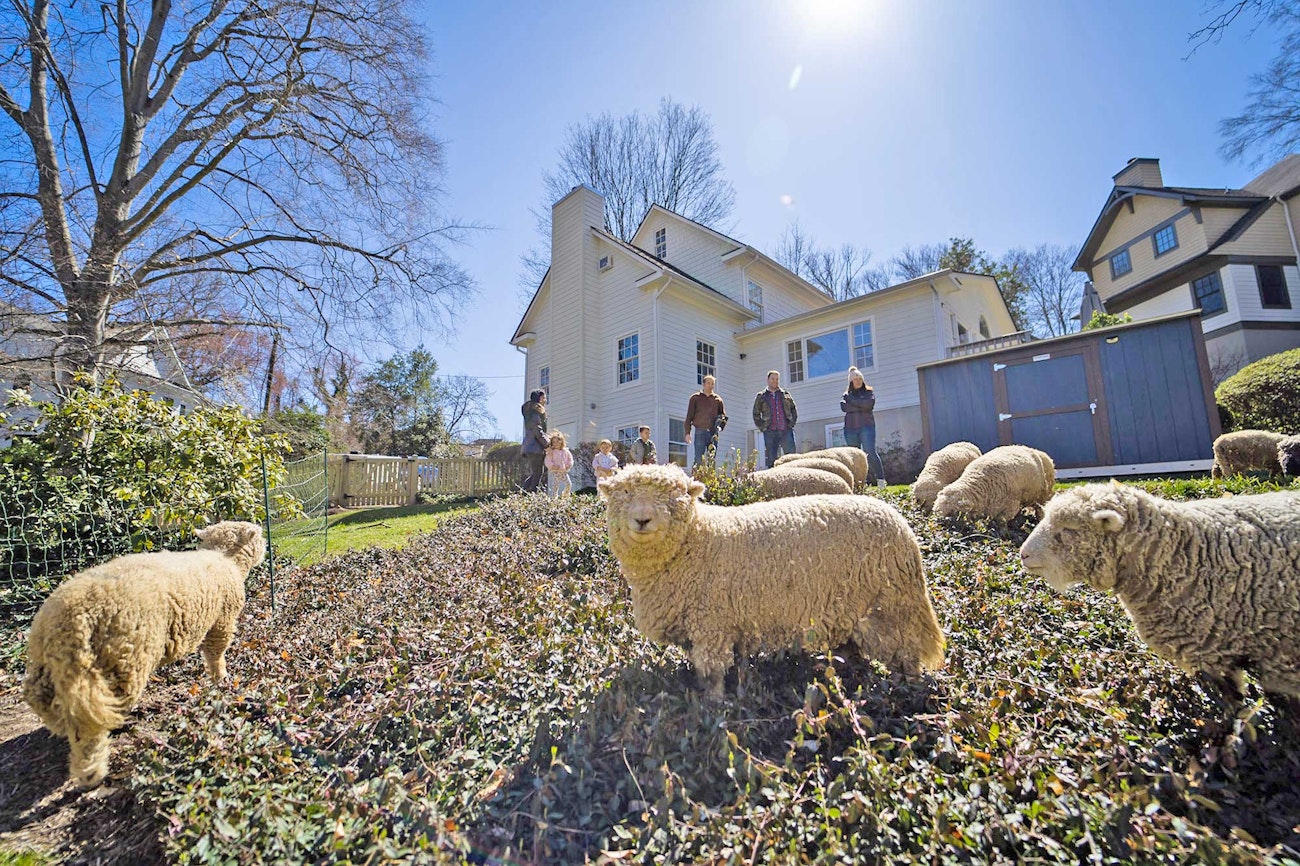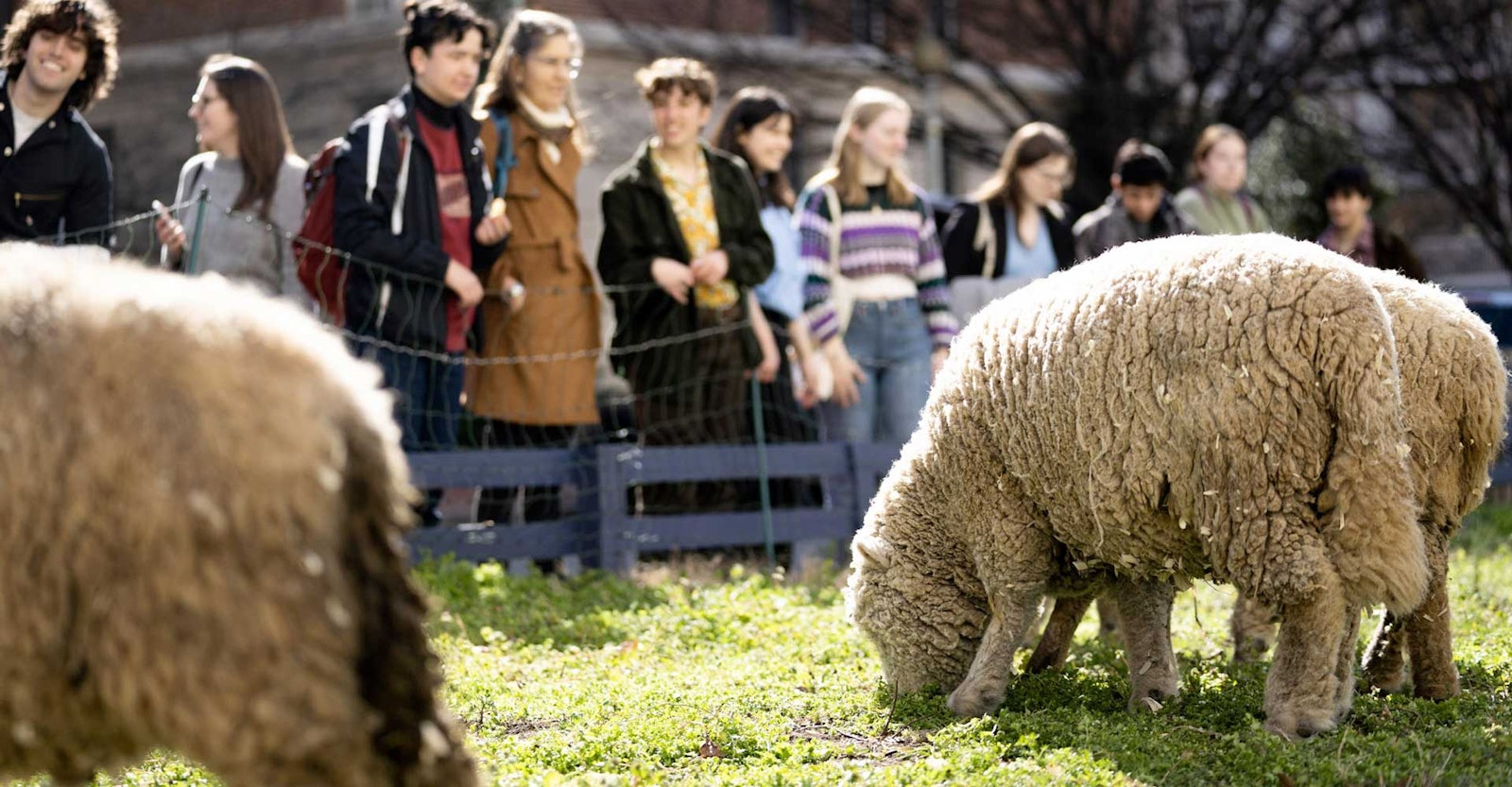I’m familiar with the many uses of sheep: for dairy, meat, and, of course, wool. But mowing lawns? In northern Virginia, Cory Suter of LambMowers.com owns an adorable flock of Babydoll Southdowns that mow suburban yards—they weed, trim grass, and fertilize private urban yards and gardens. My friend Rachel met Cory and his sheep at a lamb mowing party, and while everyone enjoyed watching the cute sheep grazing on the homeowner’s property, Rachel chatted with Cory and was invited to attend a shearing. She later brought home 12 fleeces for us to process.
Cory started working on his business plan for LambMowers in 2014 and purchased the web domain for the future business. After years of using his flock to graze on the small permaculture farm he owns with his wife, he launched the urban lawn-mowing business in 2021 and is still going strong.1 The goal was to provide “chemical-free weed and feed” urban lawn and garden care. The sheep often like weeds—especially yard nuisances, including bindweed, dandelions, creeping Charlie, oniongrass, and clover—more than turf grasses. Because the sheep have preferences, the lawn mowing is not perfect. The “feed” part of this equation is the sheep waste left behind, conveniently and naturally pelletized. This organic, low-odor, biodegradable fertilizer quickly begins to break down and nourish plants and soil life. Plus, small hooves can help improve the soil.
 The sheep often like weeds—especially yard nuisances—more than turf grasses.
The sheep often like weeds—especially yard nuisances—more than turf grasses.
In the northern Virginia area, Cory takes the sheep to homeowners’ yards, community gardens, church grounds, and birthday parties. Parties, both planned and unplanned, develop around the mowing. The sheep provide an added mental health benefit, as cited in a study at University of California, Davis, in which participants reported lower stress levels after observing the sheep.2 But it’s not all work and no play for these sheep; recently, they starred in a music video before going to their day job of eating weeds.
 Cory wearing a hat Laureen spun and knitted for him using his flock’s wool. Photo by Cory Suter
Cory wearing a hat Laureen spun and knitted for him using his flock’s wool. Photo by Cory Suter
Why Babydoll Southdown?
Cory’s sheep have a serious cute factor and sweet dispositions; people love them. He provides alfalfa pellets (also known as sheep candy) for folks to give to the flock. Additionally, Babydolls are good mothers, easily kept within temporary fences, and small. Being small has benefits. Their short stature means most trees are safe from being munched as the sheep graze. Also, Cory can get 14 sheep into a 12-by-6-foot trailer, making transport to most urban areas possible. He is currently breeding his sheep to be small with sweet temperaments on his five-acre farm.
When I talked with Cory in the fall of 2023, his flock had already grazed well over one hundred properties that year. He believes this kind of business can provide a good revenue stream for shepherds near other urban areas and has plans to offer other shepherds the opportunity for a LambMowers franchise. Cory and his Babydolls have received local and national attention, and judging by the number of queries Cory has received, there is interest in a “chemical-free weed and feed” service outside of the mid-Atlantic area. Cory says he would “love to help other shepherds have a new revenue stream” that also helps heal the environment.
 Cory’s Babydoll Southdowns have a sweet disposition.
Cory’s Babydoll Southdowns have a sweet disposition.
The Fleece Haul
The amount of vegetable matter (VM) and second cuts in the skirted fleece wasn’t too bad for sheep doing this kind of work. Cory is clear that he is not focused on wool production. The dirty white fleeces became a soft white when washed. Rachel and I opened the locks, removed obvious VM, rinsed the locks with cold water, soaked them in hot tap water with Unicorn Power Scour, and rinsed again with warm-to-the-touch water. We repeated the process until the rinse water looked clean.3 The fleece was interesting and varied. Some fiber was coarse with little crimp; some had wonderful crimp. The staple length ranged from 1 to 3 inches (2.5 to 7.6 centimeters).
The relatively short fiber suggested that a woolen preparation would be the best fit for most of the washed fleece. After three passes through my Clemes and Clemes drumcarder, I divided the batt into quarters lengthwise and spun the resulting strips, picking out any VM and second-cut nepps as I worked. The nicest longer locks could be combed. The resulting worsted preparation—handcombed sliver—had very little VM. I set the combed slivers aside and started exploring the batts first.

Top from left: A raw lock and washed locks from different parts of the fleeces. Bottom from left: Bulky-weight yarn from Laureen’s first samples and worsted-weight yarn from the second samples. Photo by Matt Graves
First Sample Set: Bulky
I found the carded batts pleasurable to spin with a woolen draw on my Ashford Joy using the largest whorl. Babydoll Southdown spins up like the down fiber it is, creating an elastic woolen yarn with memory and bounce. Desiring a bulky yarn, I spun the batt strips using a backward draw (long draw) to create S-spun singles for a Z-spun two-ply. The resulting 800 yards varied from about 750 to less than 650 yards per pound (ypp), measuring between bulky and super bulky. While I was happy with this squishy, lofty yarn, I wasn’t happy with the variation between skeins.
 Bulky-weight samples: handwashed and air-dried; machine-washed and machine-dried. Photo by Matt Graves
Bulky-weight samples: handwashed and air-dried; machine-washed and machine-dried. Photo by Matt Graves
Many resources mention that down-breed wool, such as Babydoll, is resistant to felting. After knitting a swatch with my lofty handspun, I put it through machine wash and dry cycles. I saw a small amount of shrinkage: about 12% in stitches per inch (width) and none in rows per inch (height).
Second Sample Set: Worsted
I wanted to get less variation between skeins, so I spun on my Ashford Joy using the second-smallest whorl and spun woolen from over the fold. This gave me more control and a more consistent yarn grist. I checked ply-back wraps per inch and angle every third batt strip. I did get more consistent yarn in a worsted-weight (970–1,141 ypp). The resulting yarn has memory and exhibited similar shrinkage: about 9% in stitches per inch and less than 1% in rows per inch.
 Worsted-weight samples: handwashed and air-dried; machine-washed and machine-dried. Photo by Matt Graves
Worsted-weight samples: handwashed and air-dried; machine-washed and machine-dried. Photo by Matt Graves
Virginia and Beyond
While there is some use of sheep in maintenance of commercial and public properties, the LambMowers business is fairly unique since it specializes in private yards and local community gardens. Currently, some electric companies use sheep to maintain solar farms.4 In Northern California, the Kaos Sheep Outfit has a sustainable business grazing Australian Corriedale sheep in vineyards, orchards, and golf courses and for homeowners’ associations.5

From western Europe to Canada to Japan, sheep are used for landscape maintenance. Munching sheep can be seen on Amazon properties, at Arlington National Cemetery, and beyond. Many organizations are replacing noisy fossil-fuel equipment with sheep. As Cory says, the sheep eat weeds, trim the grass, improve the soil, and provide non-smelly organic fertilizer. And in LambMowers’ case, the Babydolls are cute! With Cory’s plans to share his success with other shepherds, you may see lawns near you being mowed by sheep. If you ask nicely, the shepherd or shepherdess may even give you some fleece!
Notes
- Faiza Elmasry and Adam Greenbaum, “Lambs Mowing Lawns,” VOA News, September 16, 2022, voanews.com/a/6750288.html.
- Karen Nikos-Rose, “Surprising Benefits of Using Sheep as Lawn Mowers.” University of California, Davis, February 21, 2023, ucdavis.edu/curiosity/news/surprising-benefits-of-sheep-mowers.
- Judith MacKenzie, Three Bags Full, video course, learn.longthreadmedia.com.
- Natalie Johnson, “Landscape to Lambscape: How Sheep Are Reshaping Solar Farm Maintenance,” Maintenance World, August 30, 2023, maintenanceworld.com/2023/08/30/landscape-to-lambscape-how-sheep-are-reshaping-solar-farm-maintenance.
- “Kaos Sheep Outfit,” Fibershed, fibershed.org/producers/kaos-sheep-outfit.
Resources
- Coren, Michael J. “The Surprising Benefits of Switching to ‘Lamb Mowers,’” The Washington Post, October 24, 2023, washingtonpost.com/climate-environment/2023/10/24/lawn-care-mowing-sheep-grazing.
- LambMowers, lambmowers.com.
This article was first published in Spin Off Summer 2024.
Also, remember that if you are an active subscriber to Spin Off magazine, you have unlimited access to previous issues, including Summer 2024. See our help center for the step-by-step process on how to access them.
Laureen Branting considers herself a “jack of all trades and master of none,” mostly because she has textile ADD—a day washing wool, then to carding or combing, and on to spinning. All this wonderful yarn calls to be knitted or woven, used for tatting, or transformed into bobbin lace.

